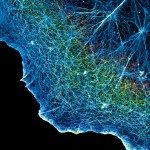Link to Pubmed [PMID] – 23644470
Nat. Cell Biol. 2013 Jun;15(6):694-9
The most dangerous insults to the genome’s integrity are those that break both strands of the DNA. Double-strand breaks can be repaired by homologous recombination; in this conserved mechanism, a global genomic homology search finds sequences similar to those near the break, and uses them as a template for DNA synthesis and ligation. Chromosomes occupy restricted territories within the nucleus. We show that yeast genomic regions whose nuclear territories overlap recombine more efficiently than sequences located in spatially distant territories. Tethering of telomeres and centromeres reduces the efficiency of recombination between distant genomic loci, lowering the chances of non-allelic recombination. Our results challenge present models that posit an active scanning of the whole nuclear volume by the broken chromosomal end; they demonstrate that the search for homology is a limiting step in homologous recombination, and emphasize the importance of nuclear organization in genome maintenance.

